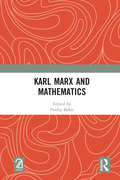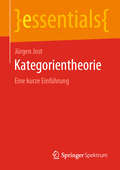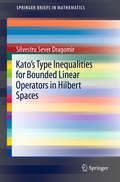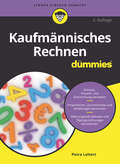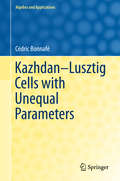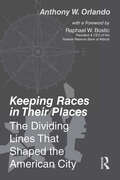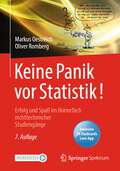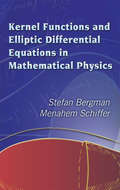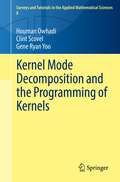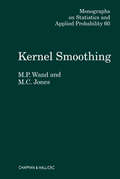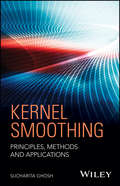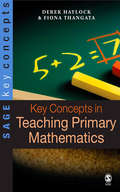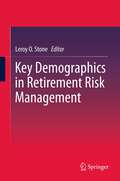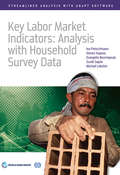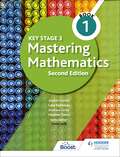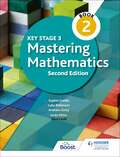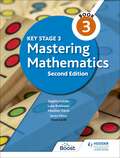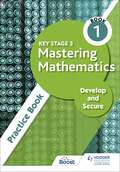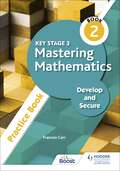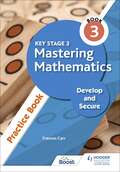- Table View
- List View
Karl Marx and Mathematics
by Pradip BaksiThis collection of various texts on Karl Marx and Mathematics is the revised and extended second edition of the Special Supplement to Karl Marx, Mathematical Manuscripts (1994; Calcutta: Viswakos) titled Marx and Mathematics. The sources of the texts included in the three parts of this collection and, some biographical information about their respective authors have been indicated at the end of each text. The emergence and development of the Ethnomathematics movement continue to change our understanding of the history of evolution of plural mathematics on planet earth since the Neolithic age. Rediscovery and study of some of the neglected source texts have further energized investigations on the subsequent history of mathematical cultures, including those on the histories of algebra and analysis in some of the ancient and medieval languages of Asia, like Sanskrit, Arabic and Malayalam. Consequently, it is now possible to indicate some of the larger gaps in the dominant understanding of history of mathematics not only in Marx’s time, but also at the time of editing Marx’s mathematical manuscripts in the twentieth century, and even today. Finally, the emergence and development of mathematical and statistical software packages are vigorously reshaping our ways of conceptualizing and doing mathematics towards an unknown future. It is time now for taking yet another look at all mathematical text from the past and that includes the mathematical manuscripts of Marx. These texts have been divided into three parts. Part one contains some topical texts related to the history of emergence, development, editing, publication and reception of the mathematical manuscripts of Karl Marx. Part two contains a selection of five articles reflecting some of the investigations inspired by these manuscripts in Russia, India and France. Part three contains five articles on plural mathematics before and after Karl Marx (1818-1883). The texts in this collection are followed by two appendices containing two bibliographies: one on Hegel and mathematics and, the other on mathematics and semiotics. Please note: This title is co-published with Aakar Books, Bew Delhi. Taylor & Francis does not sell or distribute the print edition in South Asia (India, Sri Lanka, Nepal, Bangladesh, Pakistan, Maldives or Bhutan).
Kategorientheorie: Eine kurze Einführung (essentials)
by Jürgen JostDieses essential ist eine kurze Einführung in die Kategorientheorie und damit in das strukturelle Denken der modernen Mathematik. Die Kategorientheorie erfasst Objekte durch ihre Relationen mit anderen Objekten der gleichen Strukturklasse. Sie kann daher Konstruktionen, die in verschiedenen Bereichen der Mathematik auftreten, unter universellen Gesichtspunkten erfassen. Der Autor entwickelt die grundlegenden kategorientheoretischen Begriffe und Methoden wie Morphismen, Funktoren, Prägarben, Diagramme, Limiten und Adjunktionen und erläutert diese durch Anwendungen in verschiedenen Bereichen der modernen Mathematik.
Kato's Type Inequalities for Bounded Linear Operators in Hilbert Spaces (SpringerBriefs in Mathematics)
by Silvestru Sever DragomirThe aim of this book is to present results related to Kato's famous inequality for bounded linear operators on complex Hilbert spaces obtained by the author in a sequence of recent research papers. As Linear Operator Theory in Hilbert spaces plays a central role in contemporary mathematics, with numerous applications in fields including Partial Differential Equations, Approximation Theory, Optimization Theory, and Numerical Analysis, the volume is intended for use by both researchers in various fields and postgraduate students and scientists applying inequalities in their specific areas. For the sake of completeness, all the results presented are completely proved and the original references where they have been firstly obtained are mentioned.
Kaufmannisches Rechnen fur Dummies (Für Dummies)
by Petra LeitertDreisatz, Prozentrechnen und Co. - wie ging das noch gleich? Wenn Sie einen kaufmännischen Beruf anstreben oder ausüben, führt kein Weg am Kaufmännischen Rechnen vorbei. Aber keine Sorge, auch wenn Sie kein Mathe-Genie sind, werden Berechnungen wie Proportions-, Durchschnitts-, Verteilungs- oder Zinsrechnung bald kein Problem mehr für Sie sein. Petra Leitert erklärt Ihnen leicht verständlich und Schritt für Schritt alle wichtigen Rechenarten, die Sie benötigen. So erfahren Sie alles über Abschreibungen, Währungsrechnung, Deckungsbeiträge und vieles mehr. Auch komplexere Berechnungen wie Tilgungsrechnung, Zinseszinsrechnung, Berechnungen bei Geldanlagen und statistisches Rechnen kommen nicht zu kurz. Zahlreiche Beispielrechnungen, Übungen und Tipps zur Arbeit mit Excel runden dieses Buch ab.
Kaufmännisches Rechnen für Dummies (Für Dummies)
by Petra LeitertDreisatz, Prozentrechnen und Co. - wie ging das noch gleich? Wenn Sie einen kaufmännischen Beruf anstreben oder ausüben, führt kein Weg am Kaufmännischen Rechnen vorbei. Aber keine Sorge, auch wenn Sie kein Mathe-Genie sind, werden Berechnungen wie Proportions-, Durchschnitts-, Verteilungs- oder Zinsrechnung bald kein Problem mehr für Sie sein. Petra Leitert erklärt Ihnen leicht verständlich und Schritt für Schritt alle wichtigen Rechenarten, die Sie benötigen. So erfahren Sie alles über Abschreibungen, Währungsrechnung, Deckungsbeiträge und vieles mehr. Auch komplexere Berechnungen wie Tilgungsrechnung, Zinseszinsrechnung, Berechnungen bei Geldanlagen und statistisches Rechnen kommen nicht zu kurz. Zahlreiche Beispielrechnungen, Übungen und Tipps zur Arbeit mit Excel runden dieses Buch ab.
Kazhdan-Lusztig Cells with Unequal Parameters
by Cédric BonnaféThis monograph provides a comprehensive introduction to the Kazhdan-Lusztig theory of cells in the broader context of the unequal parameter case. Serving as a useful reference, the present volume offers a synthesis of significant advances made since Lusztig’s seminal work on the subject was published in 2002. The focus lies on the combinatorics of the partition into cells for general Coxeter groups, with special attention given to induction methods, cellular maps and the role of Lusztig's conjectures. Using only algebraic and combinatorial methods, the author carefully develops proofs, discusses open conjectures, and presents recent research, including a chapter on the action of the cactus group. Kazhdan-Lusztig Cells with Unequal Parameters will appeal to graduate students and researchers interested in related subject areas, such as Lie theory, representation theory, and combinatorics of Coxeter groups. Useful examples and various exercises make this book suitable for self-study and use alongside lecture courses.Information for readers: The character {\mathbb{Z}} has been corrupted in the print edition of this book and appears incorrectly with a diagonal line running through the symbol.
Keeping Races in Their Places: The Dividing Lines That Shaped the American City
by Anthony W. Orlando"A book perfect for this moment" –Katherine M. O’Regan, Former Assistant Secretary, US Department of Housing and Urban Development More than fifty years after the passage of the Fair Housing Act, American cities remain divided along the very same lines that this landmark legislation explicitly outlawed. Keeping Races in Their Places tells the story of these lines—who drew them, why they drew them, where they drew them, and how they continue to circumscribe residents’ opportunities to this very day. Weaving together sophisticated statistical analyses of more than a century’s worth of data with an engaging, accessible narrative that brings the numbers to life, Keeping Races in Their Places exposes the entrenched effects of redlining on American communities. This one-of-a-kind contribution to the real estate and urban economics literature applies the author’s original geographic information systems analyses to historical maps to reveal redlining’s causal role in shaping today’s cities. Spanning the era from the Great Migration to the Great Recession, Keeping Races in Their Places uncovers the roots of the Black-white wealth gap, the subprime lending crisis, and today’s lack of affordable housing in maps created by banks nearly a century ago. Most of all, it offers hope that with the latest scholarly tools we can pinpoint how things went wrong—and what we must do to make them right.
Keine Panik vor Statistik!: Erfolg und Spaß im Horrorfach nichttechnischer Studiengänge
by Markus Oestreich Oliver RombergStatistik kann verständlich und witzig sein – gewürzt mit Humor und Cartoons!Dieses Lehrbuch versteht sich als humorvoller Begleiter durch das berühmt-berüchtigte „Durchfallfach“ verschiedenster Studiengänge. Es ebnet mit anschaulichen Beispielen und unterhaltsamen Erklärungen aus dem „typisch“ studentischen Alltag einen Weg ins statistische Denken – und baut eine Brücke zu ernsteren und eher theoretischen Lehrbüchern. Die Autoren stellen den Spaß beim Lernen in den Mittelpunkt, lassen dabei kein Klischee aus, nehmen sich aber auch selbst nicht allzu ernst; ihr erfrischender Stil baut übermäßigen Respekt oder gar Angst vor den Inhalten ab bzw. lässt beides gar nicht erst aufkommen. Inhalt des Buches sind die zentralen Grundlagen der Statistik, wie sie in verschiedensten Studiengängen behandelt werden: neben Grundbegriffen geht es um Kombinatorik, beschreibende Statistik, Wahrscheinlichkeitsrechnung und -verteilungen sowie beurteilende Statistik.Neben vielen Cartoons und Zeichnungen finden sich im Buch natürlich auch Übungsaufgaben mit Lösungen. Leser des gedruckten Buchs erhalten darüber hinaus kostenlosen Zugriff auf mehr als 60 Flashcards zum Buch, mit denen sie ihr Wissen in der Springer-Nature-Flashcards-App testen und ihren eigenen Leistungsstand ermitteln können.
Kernel Functions and Elliptic Differential Equations in Mathematical Physics (Dover Books on Mathematics #Volume 4)
by Stefan Bergman Menahem SchifferThis text focuses on the theory of boundary value problems in partial differential equations, which plays a central role in various fields of pure and applied mathematics, theoretical physics, and engineering. Geared toward upper-level undergraduates and graduate students, it discusses a portion of the theory from a unifying point of view and provides a systematic and self-contained introduction to each branch of the applications it employs.The two-part treatment begins with a survey of boundary value problems occurring in certain branches of theoretical physics. It introduces fundamental solutions in a heuristic way and examines their physical significance. Many concepts can be unified by concentrating upon these particular kernels, and the text explains the common mathematical background of widely varying theories, such as those of heat conduction, hydrodynamics, electrostatics, magnetostatics, and elasticity. In addition to its intrinsic interest, this material provides illustrations and exact mathematical formulation of the problems and the methods. The second part is confined to a rather special type of partial differential equation, which is dealt with in the greatest detail so that students can make applications and generalizations to similar problems.
Kernel Methods for Machine Learning with Math and Python: 100 Exercises for Building Logic
by Joe SuzukiThe most crucial ability for machine learning and data science is mathematical logic for grasping their essence rather than relying on knowledge or experience. This textbook addresses the fundamentals of kernel methods for machine learning by considering relevant math problems and building Python programs. The book’s main features are as follows:The content is written in an easy-to-follow and self-contained style.The book includes 100 exercises, which have been carefully selected and refined. As their solutions are provided in the main text, readers can solve all of the exercises by reading the book.The mathematical premises of kernels are proven and the correct conclusions are provided, helping readers to understand the nature of kernels.Source programs and running examples are presented to help readers acquire a deeper understanding of the mathematics used.Once readers have a basic understanding of the functional analysis topics covered in Chapter 2, the applications are discussed in the subsequent chapters. Here, no prior knowledge of mathematics is assumed.This book considers both the kernel for reproducing kernel Hilbert space (RKHS) and the kernel for the Gaussian process; a clear distinction is made between the two.
Kernel Methods for Machine Learning with Math and R: 100 Exercises for Building Logic
by Joe SuzukiThe most crucial ability for machine learning and data science is mathematical logic for grasping their essence rather than relying on knowledge or experience. This textbook addresses the fundamentals of kernel methods for machine learning by considering relevant math problems and building R programs. The book’s main features are as follows:The content is written in an easy-to-follow and self-contained style.The book includes 100 exercises, which have been carefully selected and refined. As their solutions are provided in the main text, readers can solve all of the exercises by reading the book.The mathematical premises of kernels are proven and the correct conclusions are provided, helping readers to understand the nature of kernels.Source programs and running examples are presented to help readers acquire a deeper understanding of the mathematics used.Once readers have a basic understanding of the functional analysis topics covered in Chapter 2, the applications are discussed in the subsequent chapters. Here, no prior knowledge of mathematics is assumed.This book considers both the kernel for reproducing kernel Hilbert space (RKHS) and the kernel for the Gaussian process; a clear distinction is made between the two.
Kernel Mode Decomposition and the Programming of Kernels (Surveys and Tutorials in the Applied Mathematical Sciences #8)
by Houman Owhadi Clint Scovel Gene Ryan YooThis monograph demonstrates a new approach to the classical mode decomposition problem through nonlinear regression models, which achieve near-machine precision in the recovery of the modes. The presentation includes a review of generalized additive models, additive kernels/Gaussian processes, generalized Tikhonov regularization, empirical mode decomposition, and Synchrosqueezing, which are all related to and generalizable under the proposed framework.Although kernel methods have strong theoretical foundations, they require the prior selection of a good kernel. While the usual approach to this kernel selection problem is hyperparameter tuning, the objective of this monograph is to present an alternative (programming) approach to the kernel selection problem while using mode decomposition as a prototypical pattern recognition problem. In this approach, kernels are programmed for the task at hand through the programming of interpretable regression networks in the context of additive Gaussian processes.It is suitable for engineers, computer scientists, mathematicians, and students in these fields working on kernel methods, pattern recognition, and mode decomposition problems.
Kernel Ridge Regression in Clinical Research
by Aeilko H. Zwinderman Ton J. CleophasIBM (international business machines) has published in its SPSS statistical software 2022 update a very important novel regression method entitled Kernel Ridge Regression (KRR). It is an extension of the currently available regression methods, and is suitable for pattern recognition in high dimensional data, particularly, when alternative methods fail. Its theoretical advantages are plenty and include thekernel trick for reduced arithmetic complexity,estimation of uncertainty by Gaussians unlike histograms,corrected data-overfit by ridge regularization,availability of 8 alternative kernel density models for datafit.A very exciting and wide array of preliminary KRR research has already been published by major disciplines (like studies in quantum mechanics and nuclear physics, studies of molecular affinity / dynamics, atomisation energy studies, but also forecasting economics studies, IoT (internet of things) studies for e-networks, plant stress response studies, big data streaming studies, etc). In contrast, it is virtually unused in clinical research. This edition is the first textbook and tutorial of kernel ridge regressions for medical and healthcare students as well as recollection / update bench, and help desk for professionals. Each chapter can be studied as a standalone, and, using, real as well as hypothesized data, it tests the performance of the novel methodology against traditional regression analyses. Step by step analyses of over 20 data files stored at Supplementary Files at Springer Interlink are included for self-assessment. We should add that the authors are well qualified in their field. Professor Zwinderman is past-president of the International Society of Biostatistics (2012-2015) and Professor Cleophas is past-president of the American College of Angiology (2000-2002). From their expertise they should be able to make adequate selections of modern KRR methods for the benefit of physicians, students, and investigators. The authors have been working and publishing together for 24 years and their research can be characterized as a continued effort to demonstrate that clinical data analysis is not mathematics but rather a discipline at the interface of biology and mathematics.
Kernel Smoothing (ISSN #60)
by M.P. Wand M.C. JonesKernel smoothing refers to a general methodology for recovery of underlying structure in data sets. The basic principle is that local averaging or smoothing is performed with respect to a kernel function.This book provides uninitiated readers with a feeling for the principles, applications, and analysis of kernel smoothers. This is facilita
Kernel Smoothing: Principles, Methods and Applications
by Sucharita GhoshComprehensive theoretical overview of kernel smoothing methods with motivating examples Kernel smoothing is a flexible nonparametric curve estimation method that is applicable when parametric descriptions of the data are not sufficiently adequate. This book explores theory and methods of kernel smoothing in a variety of contexts, considering independent and correlated data e.g. with short-memory and long-memory correlations, as well as non-Gaussian data that are transformations of latent Gaussian processes. These types of data occur in many fields of research, e.g. the natural and the environmental sciences, and others. Nonparametric density estimation, nonparametric and semiparametric regression, trend and surface estimation in particular for time series and spatial data and other topics such as rapid change points, robustness etc. are introduced alongside a study of their theoretical properties and optimality issues, such as consistency and bandwidth selection. Addressing a variety of topics, Kernel Smoothing: Principles, Methods and Applications offers a user-friendly presentation of the mathematical content so that the reader can directly implement the formulas using any appropriate software. The overall aim of the book is to describe the methods and their theoretical backgrounds, while maintaining an analytically simple approach and including motivating examples—making it extremely useful in many sciences such as geophysics, climate research, forestry, ecology, and other natural and life sciences, as well as in finance, sociology, and engineering. A simple and analytical description of kernel smoothing methods in various contexts Presents the basics as well as new developments Includes simulated and real data examples Kernel Smoothing: Principles, Methods and Applications is a textbook for senior undergraduate and graduate students in statistics, as well as a reference book for applied statisticians and advanced researchers.
Key Concepts in Teaching Primary Mathematics (SAGE Key Concepts series)
by Derek HaylockCovering the key principles and concepts in the teaching and learning of mathematics in primary schools, this text provides trainee and practising teachers with a quick and easy reference to what they need to know for their course, and in the classroom. The entries are arranged alphabetically, and each contains a brief definition, followed by an explanation and discussion, practical examples and annotated suggestions for further reading. Examples of the wide-ranging material include: Anxiety about mathematics; Assessment for Learning; Cognitive conflict; Concept learning; Creativity in mathematics; Differentiation; Equivalence; Explanation; Investigation; Low attainment; Making connections; Meaningful context; Mental calculation; Numeracy; Play as a context for learning mathematics; Problem-solving; Questioning; Talk.
Key Demographics in Retirement Risk Management
by Leroy O StoneKey Demographics in Retirement Risk Management argues that the weakening of public and employer-sponsored social safety nets in several countries will permanently increase pre-retirees' risk-anxiety and create pressure towards readjustment of their expectations about the quality of their lives in retirement. The result will be to raise the priority of achieving effective comprehensive retirement related risk management. This achievement requires an emphasis upon the cascading of linked risks, and careful attention to the optimization of scarce resources used to manage those linked risks. Professional financial and retirement planning advisors comprise a key source of help. This book develops new knowledge concerning the factors that help to explain three important aspects of access to these professional advisors. The results of this analysis are used to illustrate the process of identifying distinctive population segments, key demographics, on the basis of multiple population attributes treated simultaneously. The illustration is further extended with an identification of distinctive population segments relative to performance on a composite indicator of the conduct of multiple retirement risk management activities. The book also discusses implications of the pattern of gender differences in preparedness to address retirement's challenges, highlighting subgroups of women in which inadequate preparedness is pronounced.
Key Labor Market Indicators: Analysis with Household Survey Data
by Michael Lokshin Ina Pietschmann Sajaia Evangelia Bourmpoula Steven KapsosKey Labor Market Indicators: Analysis with Household Survey Data is an introduction to labor market indicator analysis and a guide for analyzing household survey data using the ADePT ILO (International Labour Organization) Labor Market Indicators Module. The analytical framework and approach taken up in this book are based on the ILO's Key Indicators of the Labour Market (KILM). KILM indicators provide a strong basis on which to address key questions related to productive employment and decent work. The ADePT ILO Labor Market Indicators Module is a powerful tool for producing and analyzing KILM indicators using household survey data. The software allows researchers and practitioners to automate data production, to minimize data production errors, and to quickly produce a wide range of labor market data from labor force surveys or other household surveys that contain labor market information. ABOUT ADePT Streamlined Analysis with ADePT Software is a series that provides academics, students, and policy practitioners with a theoretical foundation, practical guidelines, and software tools for applied analysis in various areas of economic research. ADePT Platform is a software package developed in the research department of the World Bank (see www.worldbank.org/adept). The series examines such topics as sector performance and inequality in education, the effectiveness of social transfers, labor market conditions, the effects of macroeconomic shocks on income distribution and labor market outcomes, child anthropometrics, and gender inequalities.
Key Stage 3 Mastering Mathematics Book 1
by Sophie Goldie Luke RobinsonWith small steps and our carefully crafted questions, every pupil will achieve greater progress.Designed to be used flexibly, this second edition textbook has been updated to include more Mastery-style questions and whole-class activities. Whether you follow a full Mastery scheme, choose to use Mastery aspects or you're just looking for quality resources, our three textbooks support the way you want to teach.Each book gradually builds on prior knowledge, developing pupils' confidence, fluency, reasoning and problem-solving skills.· Secure understanding with differentiated questions and worked examples that build on prior knowledge, following the 'do it, secure it, deepen it' Mastery structure· Recap skills and topics from Key Stage 2, ensuring a smooth transition to Key Stage 3· Target key skills using the fluency, reasoning and problem-solving markers in the margin· Build confidence with starter activities and warm-up questions to introduce each concept· Develop reasoning skills using non-examples, where pupils identify mistakes in sample answers· Track progress through review questions, building key skills and knowledge· Benefit from the expertise of UK Mastery trained subject specialists with over 30 years of teaching experience· Cover the full UK National Curriculum and all four strands - number, algebra, geometry and measures, statistics and probability - within our three restructured textbooks for Key Stage 3Our flexible, Mastery-led approachOur flexible approach allows you to teach maths your way. You can choose to focus on building understanding using the graduated questions or take a Mastery approach to exposition using manipulatives and 'concrete, pictorial, abstract' in the optional class activities.Answers will be provided online.
Key Stage 3 Mastering Mathematics Book 2
by Sophie Goldie Luke Robinson Andrew GintyWith small steps and our carefully crafted questions, every pupil will achieve greater progress.Designed to be used flexibly, this second edition textbook has been updated to include more Mastery-style questions and whole-class activities. Whether you follow a full Mastery scheme, choose to use Mastery aspects or you're just looking for quality resources, our three textbooks support the way you want to teach.Each book gradually builds on prior knowledge, developing pupils' confidence, fluency, reasoning and problem-solving skills.· Secure understanding with differentiated questions and worked examples that build on prior knowledge, following the 'do it, secure it, deepen it' Mastery structure, building on prior knowledge from Book 1· Target key skills using the fluency, reasoning and problem-solving markers in the margin· Build confidence with starter activities and warm-up questions to introduce each concept· Develop reasoning skills using non-examples, where pupils identify mistakes in sample answers· Track progress through review questions, building key skills and knowledge· Benefit from the expertise of UK Mastery trained subject specialists with over 30 years of teaching experience· Cover the full UK National Curriculum and all four strands - number, algebra, geometry and measures, statistics and probability - within our three restructured textbooks for Key Stage 3Our flexible, Mastery-led approachOur flexible approach allows you to teach maths your way. You can choose to focus on building understanding using the graduated questions or take a Mastery approach to exposition using manipulatives and 'concrete, pictorial, abstract' in the optional class activities.Answers will be provided online.
Key Stage 3 Mastering Mathematics Book 3
by Heather Davis Sophie Goldie Luke RobinsonWith small steps and our carefully crafted questions, every pupil will achieve greater progress.Designed to be used flexibly, this second edition textbook has been updated to include more Mastery-style questions and whole-class activities. Whether you follow a full Mastery scheme, choose to use Mastery aspects or you're just looking for quality resources, our three textbooks support the way you want to teach.Each book gradually builds on prior knowledge, developing pupils' confidence, fluency, reasoning and problem-solving skills.· Secure understanding with differentiated questions and worked examples that follow the 'do it, secure it, deepen it' Mastery structure, building on prior knowledge from Book 2· Target key skills using the fluency, reasoning and problem-solving markers in the margin· Build confidence with starter activities and warm-up questions to introduce each concept· Develop reasoning skills using non-examples, where pupils identify mistakes in sample answers· Track progress through review questions, building key skills and knowledge so students will be prepared for the next step up to GCSE· Benefit from the expertise of UK Mastery trained subject specialists with over 30 years of teaching experience· Cover the full UK National Curriculum and all four strands - number, algebra, geometry and measures, statistics and probability - within our three restructured textbooks for Key Stage 3Our flexible, Mastery-led approachOur flexible approach allows you to teach maths your way. You can choose to focus on building understanding using the graduated questions or take a Mastery approach to exposition using manipulatives and 'concrete, pictorial, abstract' in the optional class activities.Answers will be provided online.
Key Stage 3 Mastering Mathematics Develop and Secure Practice Book 1
by Frances CarrBuild key fluency and reasoning skills and prepare for problem-solving with extra practice. This book is packed with questions that take small steps to enable sustained progress and is perfect for intervention.- Bridge the gap from KS2 to KS3 by recapping the key skills and content needed for KS3- Develop knowledge and understanding with practice questions that get progressively more difficult following a Mastery approach to learning- Support pupils with helpful reminders and explanations alongside hints for trickier questions- Help to engage pupils with questions that relate maths to outside of the classroom and plenty of colourful images- Enable home learning with answers available online
Key Stage 3 Mastering Mathematics Develop and Secure Practice Book 2
by Frances CarrBuild key fluency, reasoning and problem-solving skills with extra practice. This book is packed with questions that take small steps to enable sustained progress and is perfect for intervention.- Develop knowledge and understanding with practice questions that get progressively more difficult following a Mastery approach to learning- Support pupils with helpful reminders and explanations alongside hints for trickier questions- Help to engage pupils with questions that relate maths to outside of the classroom and plenty of colourful images- Enable home learning with answers available online
Key Stage 3 Mastering Mathematics Develop and Secure Practice Book 3
by Frances CarrBuild key fluency, reasoning and problem-solving skills with extra practice. This book is packed with questions that take small steps to enable sustained progress and is perfect for intervention.- Develop knowledge and understanding with practice questions that get progressively more difficult following a Mastery approach to learning- Support pupils with helpful reminders and explanations alongside hints for trickier questions- Help to engage pupils with questions that relate maths to outside of the classroom and plenty of colourful images- Enable home learning with answers available online
